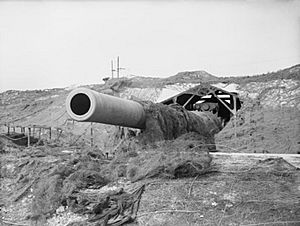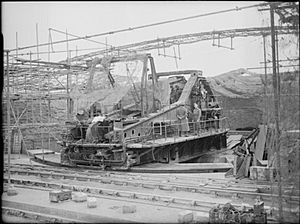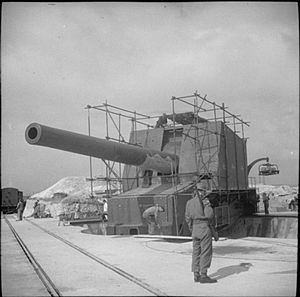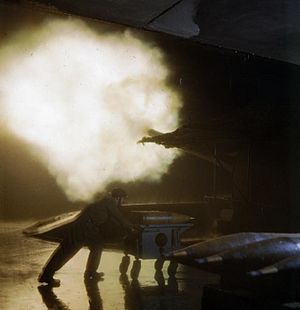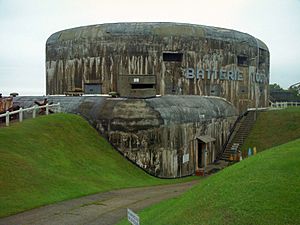Dover Strait coastal guns facts for kids
Quick facts for kids Dover Strait coastal guns |
|
|---|---|
| Part of British coast defences/Atlantikwall | |
| English Channel Near Dover/Calais in Britain/occupied France |
|
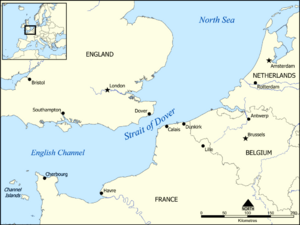
Strait of Dover
|
|
| Site information | |
| Operator | Dover Command/Kriegsmarine |
| Controlled by | British Army/German Navy |
| Condition | Museum pieces or demolished |
| Site history | |
| Built | 1940 |
| Built by | British civilian contractors/Organisation Todt |
| In use | 1944 |
| Materials | Steel-reinforced concrete |
| Fate | Defunct |
| Battles/wars | Channel convoys Channel Dash Operation Undergo |
| Events | Battle of Britain Normandy landings |
The Dover Strait coastal guns were powerful, long-range cannons used during World War II. They were placed on both sides of the English Channel, near the Strait of Dover. This strait is the narrowest part of the Channel, making it a very important spot.
The British built many gun positions along the coast of Kent, England. At the same time, the Germans built strong forts in Pas-de-Calais, which was in occupied France. Both sides used these huge guns to attack ships passing through the Channel. They also fired shells at coastal towns and military bases. The German forts later became part of the Atlantic Wall, a huge defense system built between 1942 and 1944.
Contents
German Guns: Building a Coastal Defense
After France was defeated in June 1940, Adolf Hitler planned to invade Britain. This plan was called Operation Sea Lion. To help with the invasion, Hitler ordered that strong coastal guns be put in place. These guns would protect the invasion fleet as it crossed the Channel.
Work on these gun positions began on July 22, 1940. A group called Organisation Todt built them. They made sure the batteries could survive heavy attacks.
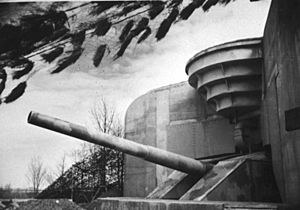
The first German guns were ready by the end of July 1940. Here are some of the main German batteries:
- Siegfried Battery (later called Todt Battery) at Audinghen. It had four 15-inch guns.
- Friedrich August Battery near Boulogne-sur-Mer. It had three 12-inch guns.
- Grosser Kurfürst Battery at Cap Gris-Nez. It had four 11-inch guns.
- Prinz Heinrich Battery near Calais. It had two 8-inch guns.
- Oldenburg Battery in Calais. It also had two 8-inch guns.
- Lindemann Battery between Calais and Cap Blanc-Nez. It had three huge 16-inch guns. This battery was named after the brave captain of the battleship Bismarck.
By early August, some batteries were fully ready. The Germans also used powerful railway guns. These guns were very large but slow to move and reload. This made it hard for them to hit moving ships. Land-based guns are usually more accurate than ship guns because they don't move.
To help their guns hit targets, the Germans used radar sets. These radar units could find targets up to 25 miles away, even small British patrol boats.
The longest-range German guns were the 8-inch Kanone 12. These guns could fire shells up to 71 miles! Shell pieces from these guns were found near Chatham, Kent, about 55 miles from the French coast.
Most of the German batteries kept firing until September 1944. By then, they had fired over a thousand shells at England and at ships. Only two ships were sunk by German coastal gun fire:
- Sambut, on June 6, 1944.
- Empire Lough, on June 24, 1944.
British Guns: Defending the Coast
After the Dunkirk evacuation and winning the Battle of Britain, Britain needed to respond to the German gun threat. Prime Minister Winston Churchill personally ordered large guns to be placed on the high ground near Port of Dover.
Britain already had two 14-inch guns called Winnie (named after Churchill) and Pooh (named after the storybook character Winnie the Pooh). These guns were spare parts from a battleship. They were well hidden and protected.
Winnie fired Britain's first shell into Europe in August 1940, which helped boost morale. However, these guns were slow to reload and not very good at hitting enemy ships.
Because these guns struggled to hit ships, Churchill ordered new, heavier gun batteries for Dover. These were operated by the Royal Artillery:
- Three 6-inch guns at Fan Bay Battery. They could fire up to 14 miles.
- Four 9.2-inch guns at South Foreland Battery. They could fire up to 17.6 miles.
- Two 15-inch guns at Wanstone Battery, named Clem (after Clementine Churchill) and Jane. They could fire up to 23.8 miles.
Later, three more 6-inch guns were added at Lydden Spout Battery. Also, three 13.5-inch naval guns from First World War were brought back and put on railway tracks.
The British coastal batteries sank several German ships:
- Pentiver, on March 2, 1943.
- Livadia, on October 4, 1943.
- Munsterland, on January 20, 1944.
- Recum, on March 20, 1944.
Life at Hellfire Corner
The constant gun battles and German shelling of Dover strait and the Dover area earned this part of the Channel the nickname Hellfire Corner. There were over 3,000 alerts, 216 civilians died, and more than 10,000 buildings were damaged in Dover.
British supply ships, called convoys, had to pass through this dangerous area. Even though the German guns fired regularly from 1940 to 1944, they only sank two ships and damaged a few others. However, the civilian sailors found the shelling very scary. Sometimes, crews refused to sail because of the German guns.
The Channel Dash: A Daring Escape
On February 11, 1942, three large German warships – Scharnhorst, Gneisenau, and Prinz Eugen – made a daring dash through the English Channel. They were moving from France back to Germany. This was called Operation Cerberus.
Due to bad weather and communication problems, the British guns struggled to hit them. The 9.2-inch guns at South Foreland Battery were the only ones with radar. But the radar was new and had not been used with the guns before. The visibility was poor, so they hoped the radar could see where the shells landed.
The British guns fired many shells, but none came close to the German ships. The German ships were almost a mile away from where the shells landed. The British guns fired for six minutes, but the ships escaped.
The Final Battles
During the Allied effort to capture Calais, on September 26, 1944, the German guns fired their last shells. Fifty shells were fired, killing five people. The last person killed was 63-year-old Patience Ransley, who was sheltering in a tunnel.
Accurate firing from the British heavy guns at Dover finally stopped the German Grosser Kurfürst Battery. This ended the long gun duels across the Channel. To celebrate Dover being free from bombardment, the town's mayor was sent a German flag from the captured batteries.
What Remains Today
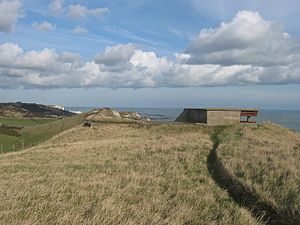
Between Calais and Boulogne-sur-Mer, many parts of the concrete gun positions and bunkers still exist. One of the gun bunkers from the Todt Battery can be visited at the Musée du Mur de l'Atlantique (Atlantic Wall Museum) in Audinghen. A German Krupp K5 gun is also there.
In Dover, a piece of armor plating from the German Lindemann Battery has been on display since 1954. Many of the British batteries remained until 1956, when all coastal artillery was removed. The big 15-inch guns at Wanstone Farm were not taken away until 1959. Many of these sites have been torn down, buried, or left to decay. At Wanstone Farm Battery, you can still see old buildings like the plotting room and guard house, though they are overgrown.
See also
- V-3 cannon
- Dover Castle
- Hougham Battery
- List of naval guns
- Operation Sea Lion
- Fan Bay Deep Shelter


